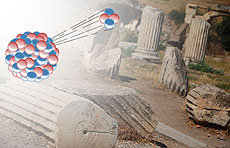In this post I have talked about the hypothetical variability of nuclear decay rate related to solar-earth distance and solar flares. But what is a subatomic decay?
Decay evokes a lot of images, from jumbled piles of stone that once composed breathtaking examples of architecture to the dank smell of a damp forest glen, with the rot of wet leaves and crumbling tree stumps filling your lungs.The word decay also shows up a lot in Fermilab Today articles, which often talk about the decay of this particle or that. Is it possible that you, the reader, might be applying a common meaning to this most uncommon situation? Just what does this familiar word mean in a particle physics context?In particle physics, decay means that a particular particle disappears and is replaced by two or more so-called decay products. Conjuring up a human metaphor, we call the initial particle a mother particle and the decay products the daughter particles. The daughter particles can in turn decay into granddaughter particles and so on until you get the final product.So let's talk about the decay of subatomic particles. There are three broad classes. We'll start with the easier ones and work our way up to the more mind-bending ones. (Continue to read on Fermilab Today) ”


No comments:
Post a Comment